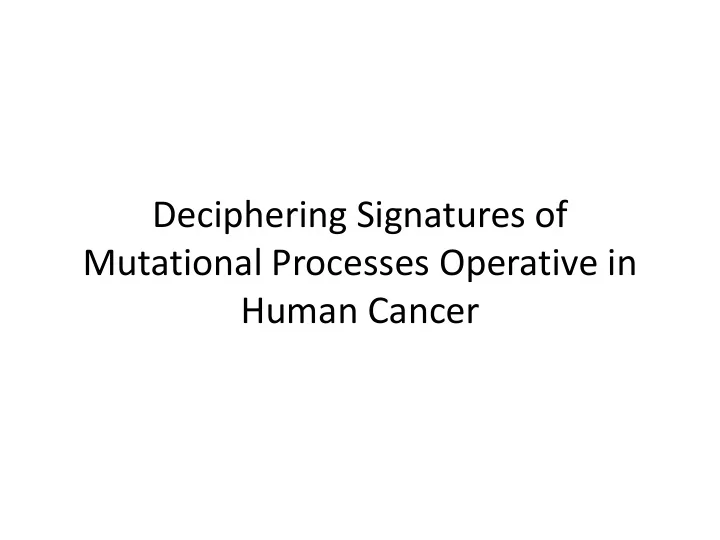

Deciphering Signatures of Mutational Processes Operative in Human Cancer
Tumor Cells Carry Somatic Mutations Tumor gcttcgctagcgcccccttttaatcgatcccgatcg cccacgatcggatagctagatcgactgtttttaatt Sequence agcccacatcactatctccctttttgggagacgatc atgccccggtttcgaatgctaaaatgctaaagttt cccacgatcggatagctagatcgactgtttttaatt cagctactgatcgttttgccggccccccgggagat atgccccggtttcgaatgctaaaatgctaaagttt Catalog 1. acgatcg 2. ctcccttt 3. tcggata 4. gactgttt 5. gccccgg ….. 500
Motivation • Catalogs have heterogeneity – Different mutation types: Substitution, missense, nonsense, indels – DNA Repair mechanisms – Passenger mutations • Many different cancer signatures
Aim to create computational framework to bridge the gap between the catalogs and signatures Catalog 1. acgatcg Lung Cancer Signature 2. ctcccttt 1. Gcgta (G:C > T:A) 3. tcggata 2. Cttccg Deletion 4. gactgttt 3. tcggata 5. gccccgg ….. 500
Feature of Signatures P = Mutational Signature p 1…k = probability P causes a certain mutation K = 96 (6 types of substitutions * 4 types of 5’ bases * 4 types of 3’ bases)
Mapping of a Genome P = process/mutation e = exposure/weight
What we end up with = X
Non-Negative Matrix Factorization • Want to extract “P” and “e” from M Step 1 and 2 Reduce Matrix Dimensions Use bootstrap resampling
Step 3&4: Non Negative Matrix Factorization • All inputs must be non-negative • Aims to recreate P and e from M Iterate until convergence Minimize Cost Function Equivalent to (K,N) th element of matrix
NMF: Faces W H Basis Encodings From Lee and Seung, 1999
NMF: Encyclopedia Breaks topics into Related words Uses context to Differentiate From Lee and Seung, 1999
Step 5: Clustering • Partition-clustering algorithm was applied to cluster data into N clusters
Step 6: Evaluate • Look at Frobenius reconstruction error to evaluate for accuracy • Compare mutational signatures: Sim(A,B) = 1 means same signature
Does it work?
Breast Cancer Example
Impact • Ability to generate cancer signatures from comprehensive ‘ omic data • Opens the door for further work. Eg. Sparsity constraint to use a minimum number of signatures
Recommend
More recommend